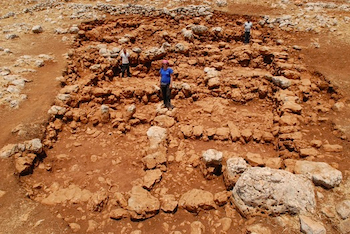The fact is the excavators found a modern 20th-century Bedouin bracelet and not a Canaanite bracelet
By Robert Deutsch
Archaeologist
Tel Aviv
August 2010
The Israel Antiquities Authority Press Office announced:

An extraordinary and unique artifact discovered in an excavation fascinates archaeologists at the Israel Antiquities Authority: A Rare Bronze Horned-Bracelet, 3,500 Years Old. Hypothesis: It was used by the village ruler!
The first known village from this period in all of northern Israel was uncovered in an excavation that took place in the vicinity of Zefat. Funding was provided by the Ministry of Transport and Ministry of Housing.
Karen Covello-Paran, director of the excavation on behalf of the Israel Antiquities Authority, discovered a wide rare bracelet made of bronze - adorned with a horned structure, which was the symbol of the storm god, and it represented power, fertility and law. (IAA Press Release).
The fact is the excavators found a modern 20th-century Bedouin bracelet and not a Canaanite bracelet. Ms. Covello-Paran stated that the site was cleaned, deserted, and nothing was found in the rooms. Please listen to her interview at: http://www.foundationstone.org/LandMinds10/page73/page73.html.

Consequently, this bracelet is the key to the dating of the building as recent. The house is on the surface and was visible before the excavation began.
In addition, in a small room (probably under the floor) the archaeologist also found a scarab seal, a bronze toggle pin, and some Canaanite shards of pottery. These finds indicate that the Bedouin house was constructed over a Canaanite burial without noticing it. The scarab, the toggle pin, and various pottery offerings are exactly what one would expect to find in a location of Canaanite burials. Therefore the bracelet dates the building and not the scarab and pottery. This means we can safely state that no new settlements have been discovered in Galilee but merely a single burial site.
It also points out the amateur level of the IAA field archaeologist in understanding the site and the finds. Moreover, the IAA Press Office released the news without checking the facts first with a professional or a team of experts. I am curious to see Ms. Covello-Paran's final excavation report. Recently I checked the IAA web site and was unable to find any news item related to the Canaanite bracelet. Perhaps they have reconsidered their claim following my criticism posted on several blogs.
Comments (2)
It's ironic that Todd Bolen published an article on the Merneptah Stele this week, showing that the scientific excavations produced a later date than what is obvious from the stele. And here in your article is a (supposed) scientific excavation producing an earlier date than what is obvious from the antiquities market.
History is fun!
Will you be offering any of these bracelets in your next IAA-licensed antiquities auction?!?!
#1 - G.M. Grena - 08/18/2010 - 03:59
And read the follow up in Hershel Shank's Biblical Archaeology Review, Nov/Dec 2010, 55–56: “What Is This?”.
#2 - Robert - 10/16/2010 - 05:21
